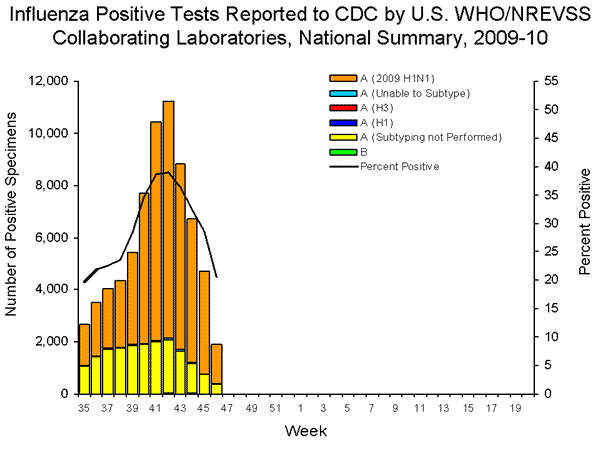Flu update
Since disease surveillance is one of my areas of interest, I thought it would be good if I gave an update of the current progress of influenza. The two main sources I use for tracking influenza are the Centers for Disease Control and Prevention and Google.org's flu trends. Overall, the good news is that it appears the peak of H1N1 flu occurred around a month ago. Before you get too excited, I suspect we will see a second peak in February which will predominantly be seasonal flu. The height of this peak, and therefore the severity of the season flu, will depend on how well the vaccine matches the circulating strains. At this point it is too early to tell how well the vaccine will match.
The CDC data is based on samples taken at reporting laboratories across the United States. Among the quantities of interest are the number of samples positive for flu and what the subtype is for these samples. In the past week (week 46), 1,880 (20.5%) samples tested positive for influenza and 1,478 (78.9%) of these were H1N1. So H1N1 is still the predominant flu strain around the U.S. Compare these numbers to the week 42 numbers where 8,268 (42.1%) samples tested positive and 5,453 (66.1%) were H1N1.
 The Google flutrends data are based on the number of google searches for flu-like terms. The actual terms are unknown to avoid the possibility of gaming the system. The google data shows that the peak of flu was also around a month ago and has been steadily decreasing since. The most recent data point suggests a leveling off of this decrease and therefore a possibility of a new peak upcoming. I guess we'll see.
The Google flutrends data are based on the number of google searches for flu-like terms. The actual terms are unknown to avoid the possibility of gaming the system. The google data shows that the peak of flu was also around a month ago and has been steadily decreasing since. The most recent data point suggests a leveling off of this decrease and therefore a possibility of a new peak upcoming. I guess we'll see.
blog comments powered by Disqus
 The Google flutrends data are based on the number of google searches for flu-like terms. The actual terms are unknown to avoid the possibility of gaming the system. The google data shows that the peak of flu was also around a month ago and has been steadily decreasing since. The most recent data point suggests a leveling off of this decrease and therefore a possibility of a new peak upcoming. I guess we'll see.
The Google flutrends data are based on the number of google searches for flu-like terms. The actual terms are unknown to avoid the possibility of gaming the system. The google data shows that the peak of flu was also around a month ago and has been steadily decreasing since. The most recent data point suggests a leveling off of this decrease and therefore a possibility of a new peak upcoming. I guess we'll see.
blog comments powered by Disqus